On May 1, 2024, I was humbled to see that my pageviews for April smashed the 10,000 mark for the first time. To be precise, Finding Poland got 10,923 pageviews. Having reached this milestone, I’d like to share some tips to achieve 10000 pageviews a month based on strategies I’ve personally deployed in recent years:
1. Interview specialists in their fields and transcribe the interviews
One of the most visited pages on Finding Poland is the Polish citizenship page. For instance, I’ve written about my personal experience obtaining Polish citizenship by descent and my wife’s (still ongoing) path to Polish citizenship through marriage.
In the autumn of 2023, it occurred to me that I could boost the authority and overall view count of posts in this page by linking up with a specialist in the field of Polish citizenship. I came up with the idea of interviewing a specialist for keyword-dense material which I would ultimately transcribe.
Michał Petrus – Your Roots in Poland
It was by chance that I came across an interview on the Kult America Podcast on YouTube. The guest was none other than Michał Petrus from Your Roots in Poland, a company based in Kraków which offers genealogy services and advisory regarding Polish citizenship. It was clear to me that Michał had exceptional knowledge in the field of Polish citizenship. Therefore, I contacted him to see if he would do an interview regarding the range of documents an applicant for Polish citizenship can trace to prove their ancestor/s were Polish citizens.
Looking at the statistics on Google Analytics for April 2024, a post on “Claiming Polish Citizenship by descent – Complete FAQ Guide” was the fourth most viewed page on Finding Poland with 536 views:
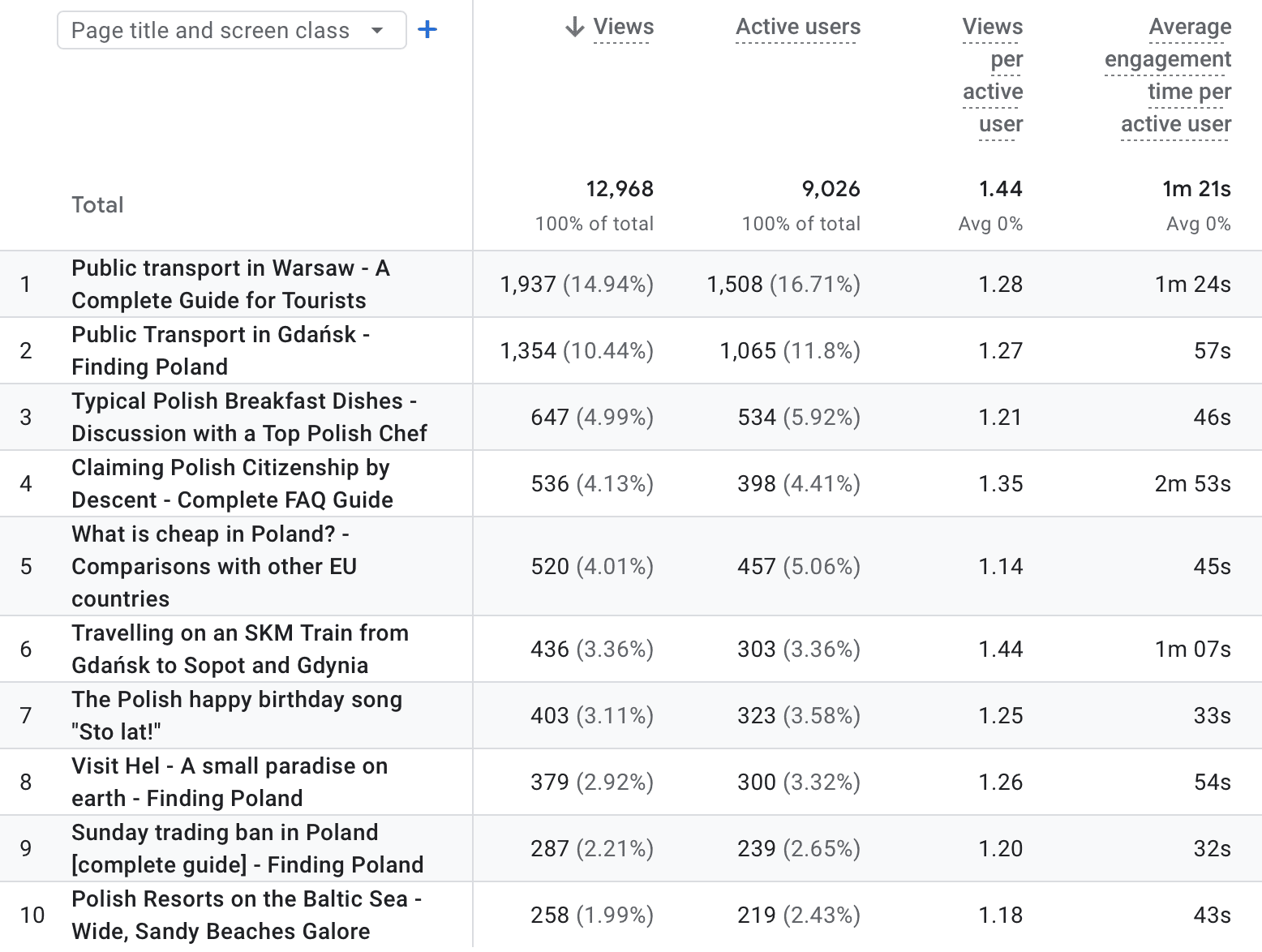
Other interviews I have done with Michał – on claiming Polish citizenship through Jewish ancestry, Polish citizenship for British citizens of Polish descent, Documents which prove Polish citizenship through ancestry, Polish Citizenship for American citizens of Polish Descent, and Obtaining Polish citizenship from the President of Poland – amassed 546 views in total.
All in all, 1,082 out of 12,968 (8.34%) of the overall page views for April 2025 resulted from three interviews with a specialist. With more interviews to come in the coming months, I wouldn’t be surprised if 10% of my pageviews will be from interviews with Michał Petrus/Your Roots in Poland by the autumn of 2024.
Richard Blanks – Brit in Poland
Back in 2023, I contacted Richard Blanks, founder of YouTube channel Brit in Poland.
The purpose of linking up with Richard was to see if he would do an interview for Finding Poland on the topic of Living in Warsaw as an expat. I also invited Richard to write a guest post. We agreed on the subject of day trips from Warsaw within easy reach by train.
I’m fairly happy that these pieces accumulated 239 views between them in April 2025:


Overall, two nifty collaborations with two very knowledgeable and experienced people led to over 1,300 page views in a single month.
Imagine what would happen to the pageview count after ten collaborations with both Michał and Richard.
In order to go from 10000 pageviews a month to 20000 pageviews a month in as short a time as possible, I believe that the way forward for Finding Poland is to collaborate with as many specialists as possible. I should seek to do this in a variety of fields, including real estate, travel, Polish citizenship, insurance, residency and Polish cuisine.
2. Put yourself in your readers’ shoes – Write about Harsh Realities
If I had to name one of my strengths, it’d be that I tell it like it is at any given opportunity.
The Cost of Living in a Big City in Poland
My very frank nature is evident in posts I’ve written about the cost of living per month in Poland and the extortionate monthly communal fees I had to pay towards the end of my time living in Gdańsk. By the end of 2024, the monthly communal costs for the building I lived in had gone up by around 109% since 2019. One particularly shocking rise occurred in May 2024 when my building management company put up fees by a shocking 28% compared with the previous month. Owners of parking spaces in the garage hall bore the brunt of that particular hike. Overall, as the owner of a 75 m2 flat and two parking spaces in Gdańsk, the final communal fee I had to pay in January 2025 was 1,138.29 zł. I rented out one of the parking spaces for 240 zł a month.
Unfortunately, I didn’t have a crystal ball in 2019 when the communal costs were only 540 zł. As the years passed, it dawned on my wife and me that we didn’t need so many square metres. Therefore, we made a concerted effort to sell our flat from the autumn of 2024. We sold the flat in January 2025.
There are people out there earning a lot more money than I do. However, those with kids and the desire to have a bit more space would have to pay upwards of 4500 zł a month to rent a 70-80 m2 apartment in Gdańsk. Add another 1000 zł for the communal fees and the word “crazy” should spring to mind.
If things are going downhill, things are going downhill
I don’t mince my words if I notice that something is getting worse. This was the case when I wrote about the rise and fall of Gdańsk’s cleanliness. Gdańsk is a clean city with a very ecologically aware and well-educated population. However, I certainly wasn’t on a mission to praise the local authorities and forest conservation mob when I wrote about how Gdańsk’s forests are becoming more and more untidy and overgrown.
Some people might, on occasion, perceive me as being a whinging expat. However, I have to stick to my personal values which revolve around frankness and putting the world to rights. The majority of my posts are overwhelmingly positive so my conscience is clear.
3. Don’t be afraid to share true stories and emotions
Many expat blogs are overly factual and worryingly devoid of emotion. They may achieve 10000 pageviews a month. However, I’m not sure whether they generate that many repeat visitors as the writers fail to create an emotional connection with readers.
Polonization
I’ll come to Finding Poland soon, but let’s consider Leah Morawiec’s blog Polonization for a moment. This is one American (now with Polish citizenship) who can be uncompromisingly forthright when it comes to the curiosities of Polish culture.
I don’t know for certain whether Leah gets 10000 pageviews a month. Frankly, I’d be very surprised if she didn’t. Her cultural musings range from navigating her way through a Polish wedding to surviving a visit with a Polish government office clerk. Leah’s blog contains an abundance of enlightening true stories.
The Sharing of Life-changing experiences, Nostalgia and Emotions
I’ve written a number of posts in which I recall the various emotions I’ve felt over the years in connection with Poland. One post which springs to mind is my piece describing what I experienced on my first journey to Poland – a thirty-hour coach journey from Nottingham to Kraków.
In that post, I didn’t shy away from revealing how I’d struck up a bond with a little girl named Malwina on the coach. We played hangman on board and I gave her piggybacks around her parents’ flat in Wrocław when I visited her and her mother. That was a few weeks after I met them on the coach.
Back to that couch journey. I don’t believe there were tears when we crossed the German-Polish border. However, great elation, relief and curiosity came over me. Psychologically, I hadn’t been myself for a few years as I didn’t adapt that well to university life in Nottingham. I deserved that journey over to Poland. To get away from it all if nothing else.
Overall, I think my readers appreciate me for the fact that I don’t shy away from revealing my emotions. As I shall go into in the next point, posts which are informative and practical can go a long way on a travel/expat blog. However, I write about travel nostalgia, life-changing experiences and the emotions I’ve felt because there needs to be variety on a blog. I am not a cold, emotionless machine.
4. Get into the minds of tourists visiting the country you live in and those planning to move to your country
It’s perhaps no surprise that most of the best-performing posts on Finding Poland in April 2025 contain extremely valuable information for both tourists and expats:
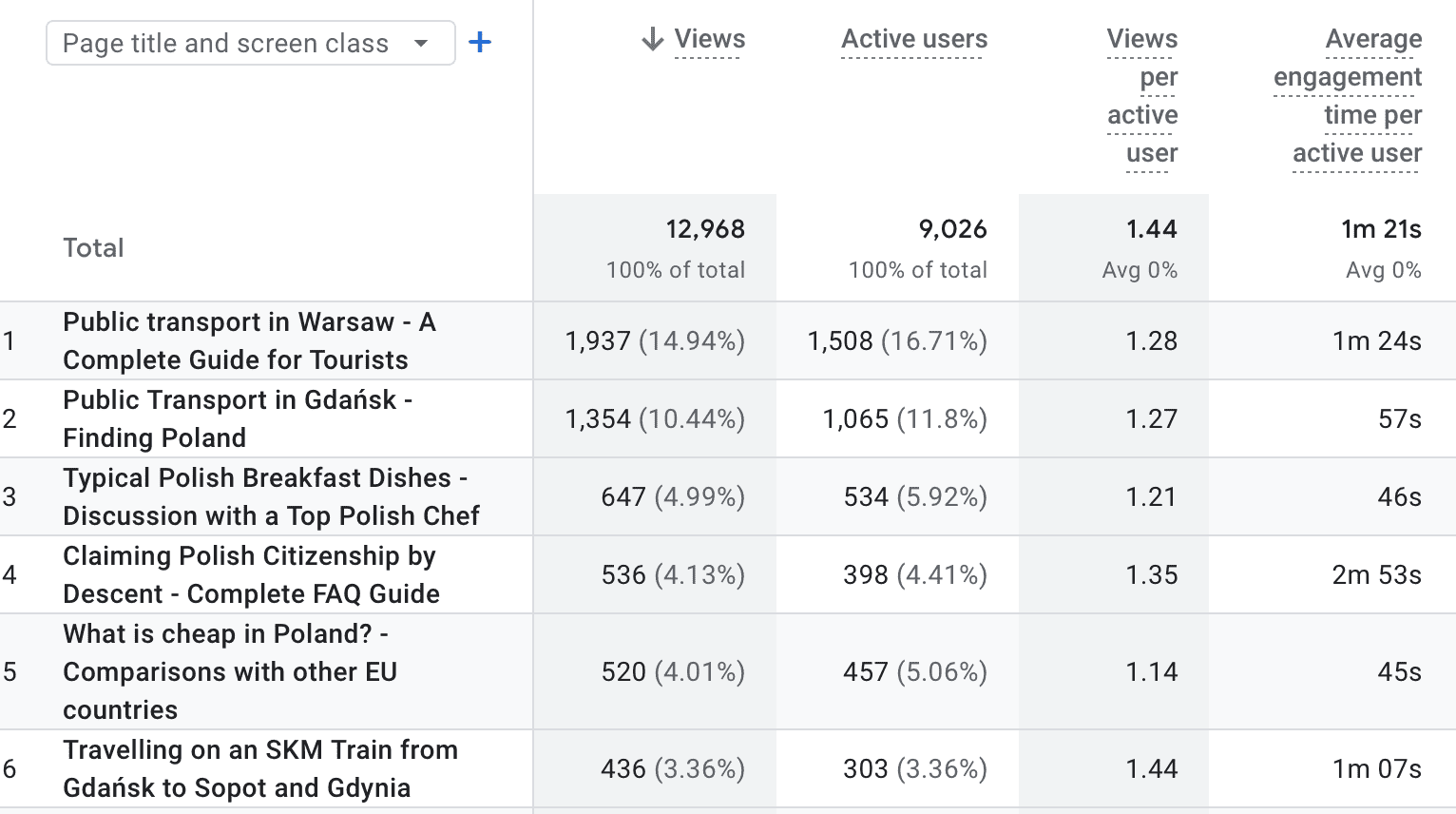
The clear leaders when it comes to page views are my posts on public transport in Warsaw and Gdańsk. In the post related to public transport in Gdańsk, I go into the reasons behind fare increases in recent years. Moreover, I share my opinions regarding the reliability, frequency and cleanliness of the buses and trams. Additionally, I compare public transport ticket prices in Gdańsk with prices in other major Polish cities. I update this post every four months or so to make sure the content is up-to-date.
As for the post – What is cheap in Poland? – I believe I hit the jackpot when I used a question for the title of the post. Presumably, tourists and those looking to move to Poland would like to know how much bang for their buck they will get when it comes to eating out, food shopping and public transport etc. Using questions as both post and SEO titles is an effective strategy because questions are highly engaging and very specific.
5. Update posts on a regular basis
When my WordPress maintenance man displayed the “Last updated” date on my blog posts some time in 2023, I’m adamant that Google pushed these updated posts up the rankings due to the newness and relevance of the content.
This “Last updated” customisation is very nifty in that it adds a valuable layer of information to readers. If they see a recent date in a travel/expat blog post, they know that the content is likely to be up-to-date and information concerning prices etc. should be accurate.
If you update your content on a regular basis, in conjunction with displaying the “Last updated” date, then the site owner, search engine users, and those already on your website will all benefit tremendously.
Adding the “Last updated” date to blog posts is helpful for SEO purposes given that search engines take newness and relevance into account when determining rankings.
My post about public transport in Gdańsk was originally published on September 3, 2022. However, when I run a quick search on Google, I see “Mar 6, 2025” next to that post’s meta description. This is because I updated the post on that date and Google’s crawler picked up on this:

It varies from day to day, but this post usually comes first or second in Google search for the keyword phrase “public transport in Gdańsk”. Even if it came in third place, it would still probably be more inviting for users to click on due to its freshness. Google has included dates on the listings for two of my competitors’ posts. However, they are more outdated than my post:
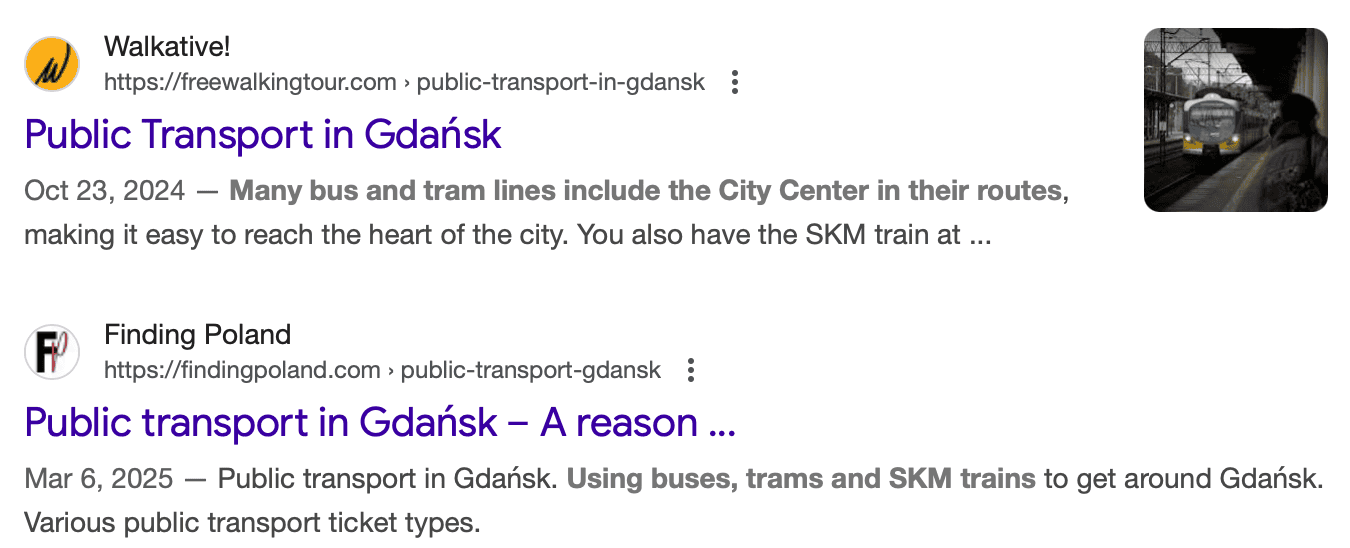

What are the main advantages of displaying the “Last Updated” date in your blog posts?
- Users notice it’s an updated post and won’t assume it’s an old one, conceivably boosting your click-through rates and the amount of time users spend reading the post
- The “Last updated” date is more accurate than the Published date. It shows that your content is likely to be more up-to-date in comparison with a post that was published several months or years ago
- Your material is more likely to stand out when you include “Last updated” dates in your posts. This is because search engines display those dates in the results and your results are surrounded by listings from other sites
- The “Last updated” date provides search engines with another means of recognising the post as fresh. It’s not always true that search engines crawl your content. Therefore, the “Last updated” date substantiates any changes made on your site
- “Last updated” dates radiate trust. Readers will assume that you’re sharing true and up-to-date content without broken images and broken links
Where should you place the “Last updated” date in your blog posts?
As for your options regarding where to place the “Last updated” date, it may depend on your theme styling. I certainly prefer for it to appear between the header image and the first paragraph of the post:
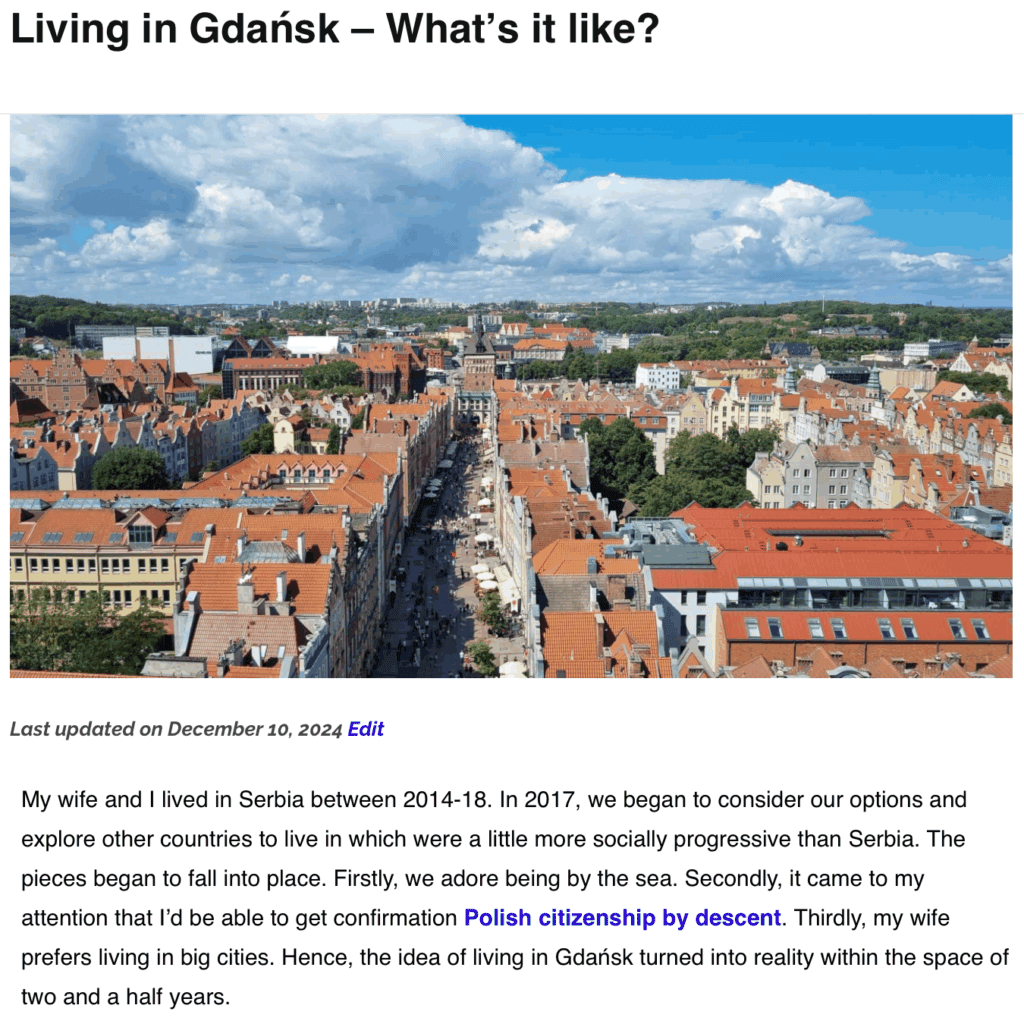
As for the publishing date, I prefer it not to appear in a blog post itself, even if it’s right at the top above the title of the post. Therefore, the publishing dates are available to view in the post grid when users click on a page:
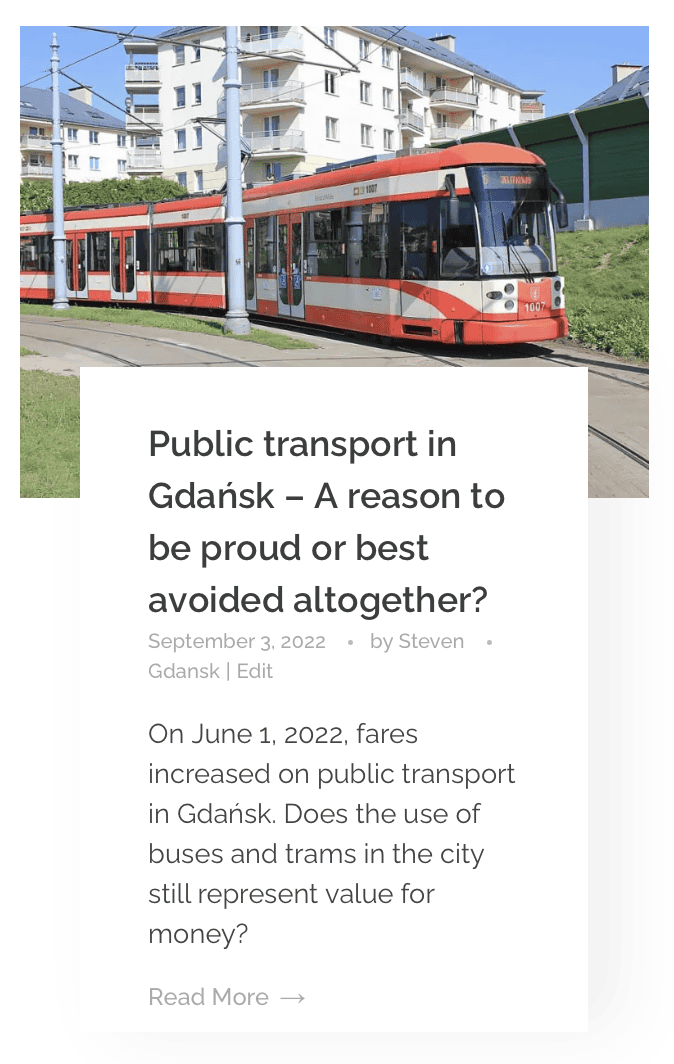
Overall, adding the “Last updated” customisation feature to all my blog posts has significantly contributed to the feat of achieving 10,000 pageviews a month for the first time in April 2024.
6. Enable FAQ Schema
As a WordPress website, Finding Poland benefits from all the features offered by the Elementor WordPress website builder.
I did a great deal of reading around on-page SEO back in 2019 because I set myself the personal goal of reaching 10,000 pageviews a month in the coming years. I didn’t have a specific timeframe in mind.
On-page SEO refers to the process of optimising your website’s content. Strategies include creating informative content and integrating target keywords. Somehow, it wasn’t until 2023 that I began to focus more heavily on adding FAQ-type questions and answers to my blog posts.
The Accordion widget on Elementor
Elementor has an excellent widget called Accordion. The Accordion widget enables bloggers to display text in a collapsed, condensed manner that’s typical of a FAQ dropdown menu. Visitors to your post or page can click on a question and the answer appears below.
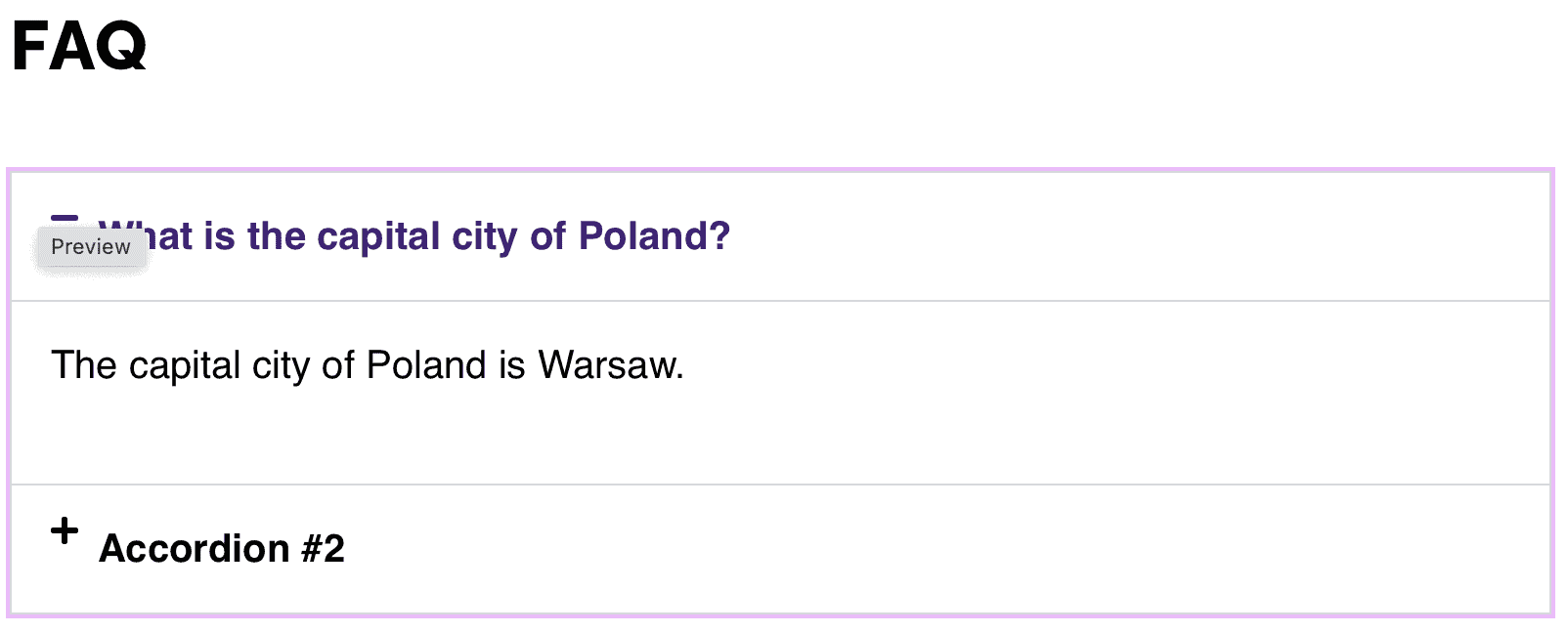
As you can see below, it’s imperative to toggle the FAQ Schema option to Yes. Essentially, this leverages the power of schema. In a nutshell, FAQ schema is a kind of code which informs search engines that content is presented in a question and answer format.
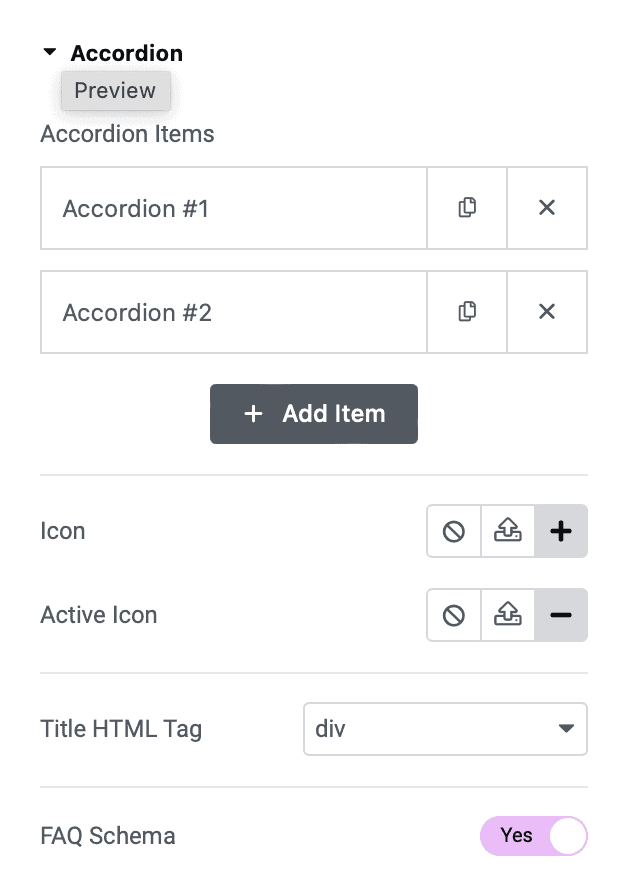
Having access to a widget like Accordion has meant that my WordPress maintenance chap didn’t have to write any schema code to enable me to generate high-quality FAQ page content.
Evidence that FAQ schema is working wonders on Finding Poland
When the content is correctly marked up, it means those pages may become eligible for rich results or featured snippets in the search results.
I don’t have to go into the various kinds of rich results here. Just to mention that FAQ rich results are one type. They contain a list of questions and answers about a particular subject matter. All of the answers are sourced from the page they appear under.
Most voice search answers are sourced from rich results. FAQ pages are beneficial for Google Assistant, Alexa, and Siri to return answers to users. This makes your website more likely to rank for long-tail keywords, which voice search queries tend to revolve around.
As an example, I’ve just carried out both a voice search and a text-based search for the long-tail question/keyword phrase, “what is cheap in Poland”. The following FAQs appear on page 1 of Google:

There are several takeaways from the searches I carried out. The first is that my content appears at the top of the list for the keyword phrase “what is cheap in Poland?”. Google has created a FAQ rich result for me as the dropdown question “What things are cheap to buy in Poland?” does not appear in my post at all. However, the heading “What is Cheap in Poland? – Top Eight Things” is my creation:
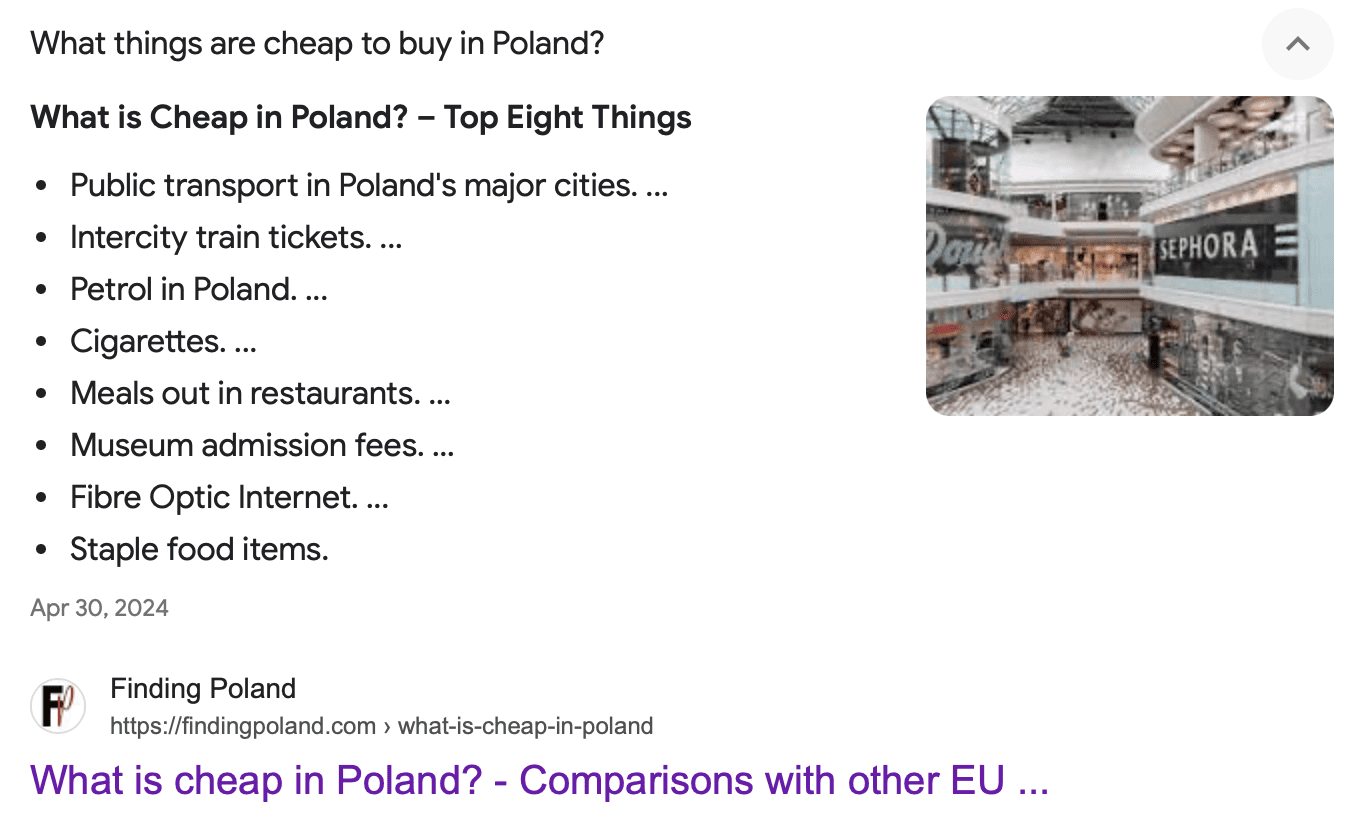
What are featured snippets?
More so than rich results, my FAQs have reaped greater rewards in the area of featured snippets.
Search engines deem featured snippets to be the best answer for a specific query. They tend to appear at the top of SERP (Search Engine Results Pages) and take up more space than a typical listing. As featured snippets are highly visible, they are an extremely precious asset when it comes to branding.
Featured snippets generally show up when a user’s query is in the form of a question. Google may display “answer” excerpts from a page or post as either a list, table of information or paragraph. Whereas the page title comes first in typical search results, it is the excerpt that is the focus in featured snippets.
In order to boost your chances of earning a featured snippet, try to anticipate audience questions and answer them in no longer than three sentences in the FAQ section of your post or page.
I must say that it’s not all roses if Google rewards you with featured snippets. By supplying a direct answer to a user’s query, you may eradicate the need for searchers to click through to your website. Anyway, I tend to think that the advantages of having featured snippets outweigh the disadvantages.
An example of a featured snippet
Voice and text Search 1 – “What’s the fastest journey time by Pendolino from Warsaw to Gdańsk”
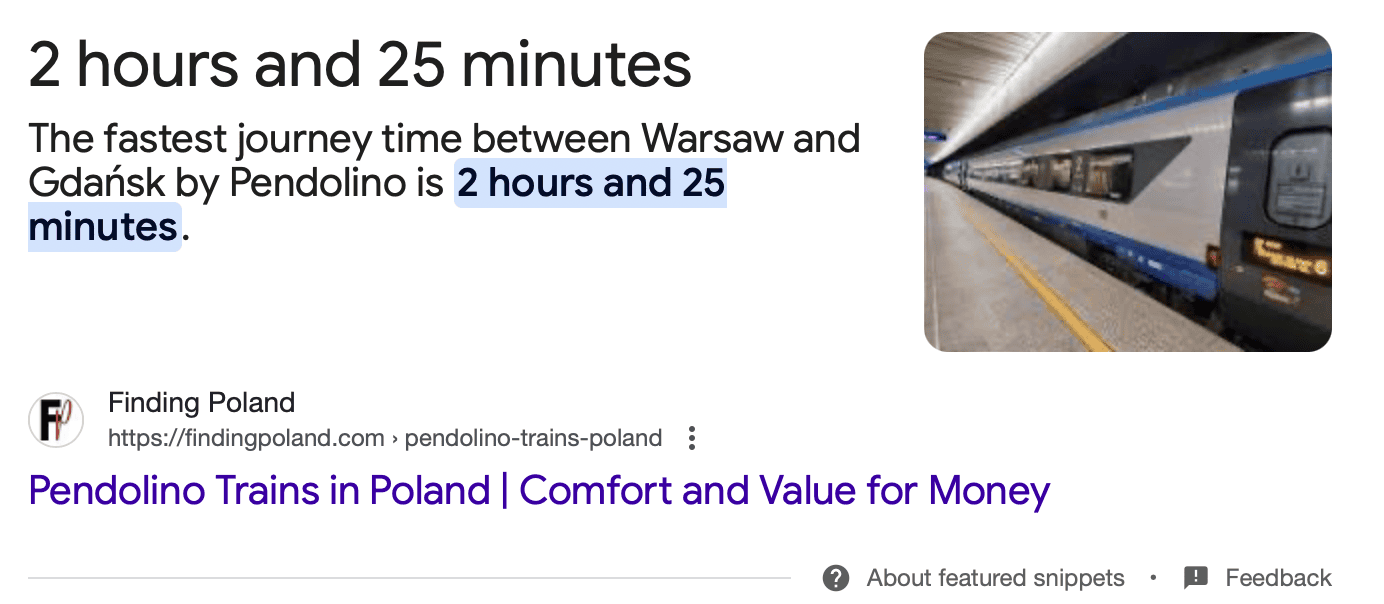
Final Thoughts on growing your blog to 10000 pageviews a month
I’ve offered six beneficial strategies to help you get 10000 pageviews a month on your blog.
I must also add that I don’t shy away from writing long-form content that informs and engages readers. My longer posts on both Finding Poland and my other site, English Coach Online, tend to get the most pageviews.
The bottom line for me though is – I’ve always liked writing. Do check out why I like writing so much. All in all, if you’re passionate about writing and find that you “lose” yourself when you’ve found that magical flow state as a writer, the pageviews will come in their thousands.

